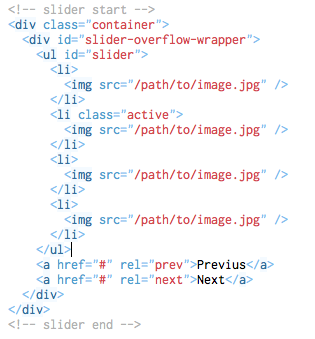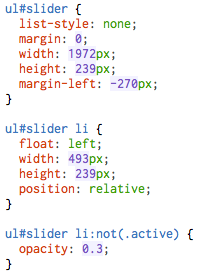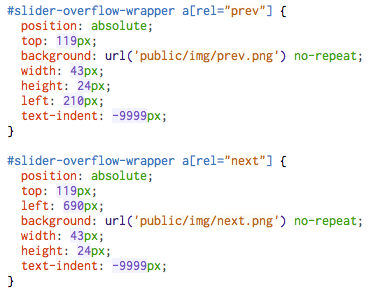My Shitty Version® By @ankutax
Making the Google Play slider

You've all seen this before. It's the Google Play slider. (A crude mockup of it.) Anyway, here's how I built my shitty version using HTML (and Javascript).
- Step One: Structure
-
The basic structure of the slider expressed as, you guessed it,
HTML.
The
.containerclass isn't required, but nice to have.
- Step Two: We're done with Structure, let's move on to Style.
-
- Give an
overflow:hiddenandposition:relativeto#slider-overflow-wrapper -
Style the
ul#sliderand it's children like this
Notice we've built the slider wide enough to stack four slides side by side inside of it. Because the slides are floated left, they'll natrually cosy up to each other. We know in advanced that this slider only needs to be four slides wide. It won't get any bigger or smaller than that. If you don't know the width, you'll have to target
ul#slideron page load and stretch its width using Javascript.Also notice that children of the slider that aren't selected have been dimmed down.
-
Lastly, target the next and previous buttons. They are just absolutely positioned anchor tags contained within the container.

- Give an
- Step Three: Javascript.
-
We have a jQuery based controller, so you need to include jQuery at the top of the page.
(function($) { var slider = $("#slider"); var next = $("#slider-overflow-wrapper a[rel='next']"); var prev = $("#slider-overflow-wrapper a[rel='prev']"); function sct_woble( element, direction ) { var o_pos = parseInt(slider.css("margin-left")); if ( direction == 'right' ) { var n_pos = o_pos - 100; } else { var n_pos = o_pos + 100; console.log(n_pos); } slider.animate( {marginLeft: n_pos}, 100, function() { slider.animate( {marginLeft: o_pos}, 500, function() {} ); } ); } next.click( function() { if ( slider.is(':animated') ) { return false; } if ( $('#slider li:last-child').attr('class') == 'active' ) { sct_woble( slider, 'right' ); return false; } var curr_pos = parseInt(slider.css("margin-left")); var new_pos = curr_pos - 493; slider.animate( {marginLeft: new_pos}, 400, function() { // move active to the next one slider.find('li.active').removeClass('active').next().addClass('active'); } ); }); prev.click( function() { if ( slider.is(':animated') ) { return false; } if ( $('#slider li:first-child').attr('class') == 'active' ) { sct_woble( slider, 'left' ); return false; } var curr_pos = parseInt(slider.css("margin-left")); var new_pos = curr_pos + 493; slider.animate( {marginLeft: new_pos}, 400, function() { // move active to the next one slider.find('li.active').removeClass('active').prev().addClass('active'); } ); }); })( jQuery );The
next.click()andprev.click()basically do the same thing and should be refactored slightly to trim code lines but here are the three main things they both do:- Don't do anything if something is already happening.
- If the user tries to slide past an edge, do a little wobble to indicate tention. The wobble motion is refactored into
sct_woble( element, direction )where the element is always the slider and the direction is either 'left' or 'right'. - Animate the slider 493 pixels to either the left or right, by tweaking the marglin-left property of the slider. 493 happens to be the width of the slide. This method only supports identically-sized images.